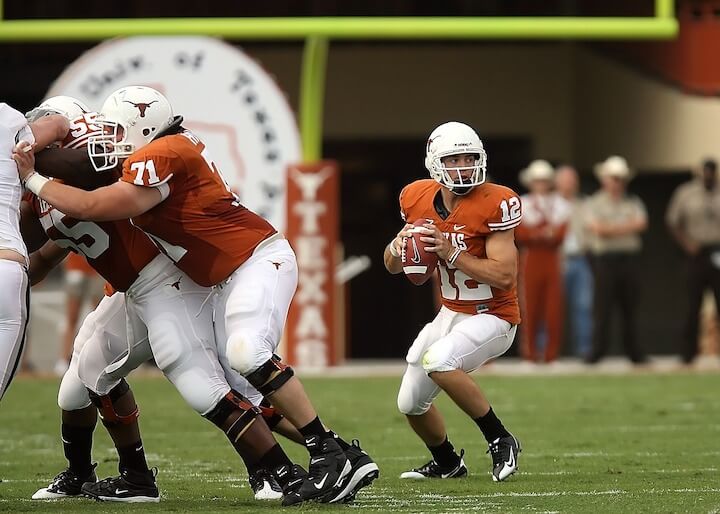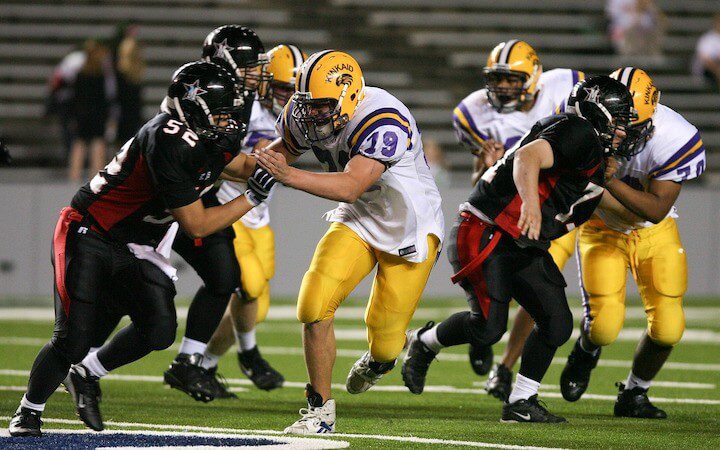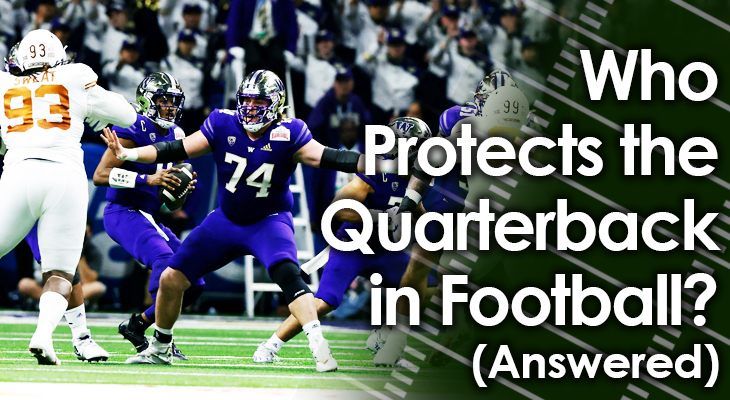All successful offenses in football have one thing in common.
No matter the base formation, offensive philosophy, or game plan, they're able to successfully protect the quarterback on a consistent basis.
The quarterback is the most important position in all of football.
No other player on either side of the ball has so much responsibility.
But the QB's success is determined by more than their own skills.
A large part of whether they do well is determined by how well the other offensive players are able to protect him.
After all, a quarterback who is constantly pressured, hit, and sacked by the defense is certainly going to have a tougher time succeeding than one who has plenty of time and space to step back and throw.
So, who protects the quarterback?
I'll answer that below...
Who Protects the Quarterback in Football?
The easy answer to this question is the offensive line.
The offensive line is the first "line of defense" for the quarterback.
In fact, the only job the offensive line has is to protect other players on their team. On passing plays, that player is the quarterback.
That's why you certainly wouldn’t be wrong if you replied to the above question by saying the offensive line.
That being said...
Running backs also play a role in protecting the QB at times, though their role in doing so is much smaller than that of offensive linemen.
Here's a position-by-position breakdown of who protects the quarterback in football.

Offensive Tackles
Offensive tackles are usually the biggest bodies on a football field.
They're usually seen as the most important offensive linemen in terms of protecting the quarterback, since they match up with a defense's best pass rushers most of the time.
Tackles are responsible for blocking speedy and strong defensive ends, outside linebackers, and Edge rushers.
This is especially true of left tackles on teams that have a right-handed quarterback, since they'll protect the quarterback's blind side.
Right tackles take on this role for teams with left-handed quarterbacks.
On most teams, the front-side tackle (the one not protecting the blind side) is the better run blocker, while the blind-side tackle is the better pass blocker.
Offensive Guards
Guards are usually much more athletic than offensive tackles.
They're normally smaller in stature and size, and often speedier.
This is because they have to move around much more than tackles.
This can be done in two ways:
1. They're often responsible for peeling off and blocking linebackers in zone blocking schemes.
2. They should also have the ability to pull from one side of the field to the other more than any other offensive linemen.
Guards line up more toward the interior of the offensive line, on either side of the center, and typically take on defensive tackles on pass plays.
While the defensive tackles are bigger players and harder to block against the run, they normally aren’t superior pass rushers.
Centers
Center is the position that starts each play with the ball in his hand.
He's responsible for snapping the football to the quarterback and then picking up his blocking assignment immediately.
He is also considered the "quarterback" of the offensive line, as his job is to call out some blocking assignments once the players get set up.
The job of a center is tough.
Protecting the QB starts with them, as a good snap will make it easier for the team to protect the quarterback while a bad snap makes it harder.
Then, they also have to snap up and pick up defenders looking to rush the quarterback straight up the middle.
They'll take on nose tackles a lot for their assignments, as well as middle linebackers.
Tight Ends
Tight ends line up to the outside of the offensive tackles.
Some are really good pass catchers and get most of their attention there.
In that role, they're more like wide receivers than offensive linemen.
That being said, all tight ends should still be able to stay in and help block from time to time.
When doing so on passing plays, they'll usually pick up outside linebackers and possibly even safeties approaching the line of scrimmage.
Running Backs
Depending on the situation, the coach may ask the running back to stay in and protect the quarterback.
In this case, he'll line up to one side of the quarterback and pick up the first defender who enters the backfield.
This is a challenging job, since it might mean that the running back needs to cross from one side of the quarterback to the other to pick up a block.
The running back is actually the last line of defense in protecting the quarterback.
If he misses a block on a defender who gets in the backfield, it could spell doom for the play.

Conclusion
Protecting the quarterback isn't the job of just one person.
It can't be, after all, since this job is one of the most important in the entire game of football.
On all teams, the primary responsibility of protecting the quarterback lies with the offensive line.
At times, tight ends and running backs will also be called on to help, though, depending on the down-and-distance, game situation and team.

